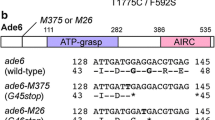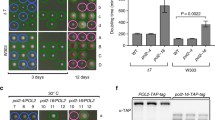Summary
Allosuppressor (sal) mutations enhance the efficiency of the yeast ochre suppressor SUQ5 and define five unlinked loci, SALT-SALS. A number of sal4 mutants were isolated and found to have pleiotropic, allele;specific phenotypes, including hypersensitivity in vivo to paromomycin and other antibiotics that stimulate translational errors in yeast. To examine further the nature of the SAL4 gene product, the wild type SAL4 gene was isolated by complementation of a conditional lethal allele sal4-2, and demonstrated to be a single copy gene encoding a single 1.6 kb transcript. Restriction mapping and DNA hybridisation analysis were used to demonstrate that the SAL4 gene is identical to the previously identified omnipotent suppressor gene SUP45 (SUPT). Our results implicate the SAL4 gene product as playing a major role in maintaining translational accuracy in yeast.
Similar content being viewed by others

References
Breining P, Piepbersberg W (1986) Nucleic Acids Res 14:5187–5197
Buckingham RH, Grosjean H (1986) In: Kirkwood TL, Rosenberger RF, Galas DJ (eds) Accuracy in molecular processes. Chapman and Hall, London, pp 83–126
Burke JF, Mogg AE (1985) Nucleic Acids Res 13:6265–6272
Caskey CT (1980) Trends Biochem Sci 5:234–237
Cox BS (1965) Heredity 20:505–521
Cox BS (1977) Genet Res 30:187–205
Cox BS, Tuite MF, Mundy CR (1980) Genetics 95:589–609
Craigen WJ, Cook RG, Tate WP, Caskey CT (1985) Proc Natl Acad Sci USA 82:3616–3620
Crouzet M, Tuite MF (1987) Mol Gen Genet 210:581–583
Cryer DR, Eccleshall R, Marmur J (1975) Methods Cell Biol 12:39–44
Dequard-Chablat M, Coppin-Raynal E, Picard-Bennoun M, Madjar JJ (1986) J Mol Biol 190:167–175
Eustice DC, Wakem LP, Wilhelm JM, Sherman F (1986) J Mol Biol 188:207–214
Gorini L (1974) In: Nomura M, Tissieres A, Lengyel P (eds) Ribosomes. Cold Spring Harbor Laboratory, Cold Spring Harbor, NY, pp 791–804
Harley CB, Pollard JW, Stanners CP, Goldstein S (1981) J Biol Chem 256:10786–10794
Himmelfarb HJ, Maicas E, Friesen JD (1985) Mol Cell Biol 5: 816–822
Hinnen A, Hicks JB, Fink GR (1978) Proc Natl Acad Sci USA 75:1929–1933
Holmes DS, Quigley M (1981) Anal Biochem 114:193–197
Kushnirov VV, Ter-Avanesyan MD, Telckov MV, Surguchov AP, Smirnov VN, Inge-Vechtomov SG (1988) Gene 66: 45–54
Liebman SW, Cavenagh M (1980) Genetics 95:49–61
Loftield RB, Vanderjagt D (1972) Biochem J 128:1353–1356
Lorincz A (1984) Focus 6:11
Mandel M, Higa A (1970) J Mol Biol 53:154–162
Maniatis T, Fritsch EF, Sambrook J (1982) Molecular cloning: a laboratory manual. Cold Spring Harbor Laboratory, Cold Spring Harbor, NY
Masurekar N, Palmer E, Ono B-I, Wilhelm JM, Sherman F (1981) J Mol Biol 147:381–390
McIntosh M, Haynes RH (1986) Mol Cell Biol 6:1711–1721
McMaster GK, Carmichael G (1977) Proc Natl Acad Sci USA 74:4835–4838
Palmer E, Wilhelm JM, Sherman F (1979) Nature 277:146–148
Piepersberg W, Geyl D, Hummel H, Bock A (1980) In: Osawa S, Ozeki H, Uchida H, Hura T (eds) Genetics and evolution of transcriptional and translational apparatus. Kodansha Scientific, Tokyo, pp 359–377
Rigby PWJ, Dieckmann M, Rhodes C, Berg P (1977) J Mol Biol 113:237–251
Sherman F, Fink GR, Hicks JB (1979) Methods in yeast genetics. Cold Spring Harbor Laboratory, Cold Spring Harbor, NY
Singh A, Ursic D, Davies J (1979) Nature 277:148–150
Song JM, Liebman SW (1987) Genetics 115:451–460
Southern EM (1975) J Mol Biol 98:503–517
Spalding A, Tuite MIT (1989) J Gen Microbiol (in press)
Surgochov AP, Smirnov VN, Ter-Avanesyan MD, Inge-Vechtomov SG (1984) Physicochem Biol Rev 4:147–205
Tapio S, Kurland CG (1986) Mol Gen Genet 205:186–188
Thomas P (1980) Proc Natl Acad Sci USA 77:5201–5205
Thompson RC, Dix DB, Karim AM (1986) J Biol Chem 261: 4868–4874
Tuite MF, McLaughlin CS (1984) Biochim Biophys Acta 783: 166–170
Vijgenboom E, Vink T, Kraal B, Bosch L (1985) EMBO J 4: 1049–1052
Weiss RB, Murphy JP, Gallant JA (1984) J Bacteriol 158:362–364
Wilson PG, Culbertson MR (1988) J Mol Biol 199:559–573
Young CSH, Cox BS (1971) Heredity 26:413–422
Author information
Authors and Affiliations
Rights and permissions
About this article
Cite this article
Crouzet, M., Izgu, F., Grant, C.M. et al. The allosuppressor gene SAL4 encodes a protein important for maintaining translational fidelity in Saccharomyces cerevisiae . Curr Genet 14, 537–543 (1988). https://doi.org/10.1007/BF00434078
Received:
Issue Date:
DOI: https://doi.org/10.1007/BF00434078



